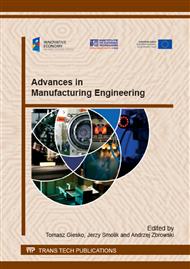p.308
p.316
p.325
p.333
p.340
p.348
p.355
p.362
p.374
Stresses in a Cr-Ni Superficial Steel Layer Based on X-Ray Measurements and Electropolishing
Abstract:
Research of residual stresses in steel at different depths from its surface is presented in this paper. The material used for research was AISI 310S heat resistant steel (containing approx. 0.2%C, 25%Cr and 20%Ni) in form of a rolled steel sheet with a thickness of 2mm. Stress measurements were conducted with the use of KαCo radiation by the sin2ψ method in three directions, including the direction of the sheet's rolling (φ = 0°). For the purpose of measuring stresses at different depths from the surface, the steel underwent the process of electropolishing in electrolyte based on perchloric acid at 32 V for various durations (every 1-5 s) to the maximum depth of 35 μm. The set residual stress distributions vary depending on the direction of the test. The strongest stresses are on the steel's surface, and stresses have the widest range (from compressing to streching ones) in the area under the surface, which occurred in the rolling direction, and the narrowest range in its transverse direction. A correlation was discovered in the distribution of compression stresses and microhardness in the outer layer of the steel to a depth of 10 μm, where the role of plastic deformation in shaping the qualities of the steel outweighs the influence of structure content. This was proven using polar figures.
Info:
Periodical:
Pages:
355-361
Citation:
Online since:
November 2014
Authors:
Price:
Сopyright:
© 2015 Trans Tech Publications Ltd. All Rights Reserved
Share:
Citation:


